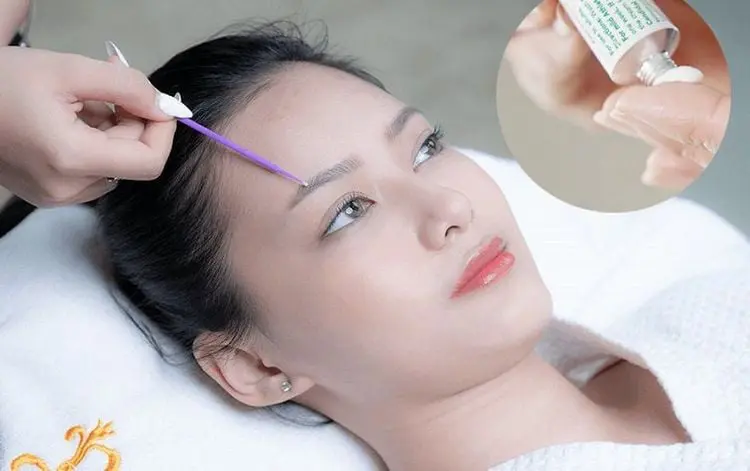1. How to care for your eyebrows after microblading/ tattooing
Immediately after the cosmetic eyebrow tattooing procedure, you may feel tingling, burning, or slight swelling around the treated area. This is because the numbing cream/ointment applied before the procedure begins to wear off, and the wound starts the healing process.
In addition, most clients will experience sensitivity, redness, and swelling in the area for about 1–2 days. At this stage, you may consider using over-the-counter pain relievers, but you should never apply tetracycline ointment or any other topical medication whose effects are unclear. It is also important to know the correct way to apply ointment after eyebrow tattooing in order to minimize irritation and further damage.
During the initial healing period, avoid any physical activities such as swimming or sauna, and limit direct sun exposure, as these may cause premature fading of the pigment. Like all tattoos, eyebrow tattoos carry a natural risk of skin infection and/or allergic reactions. If pain persists for more than a few days, seek medical advice immediately.
Finally, do not touch your eyebrows directly with your hands. Treat the area very gently—rubbing, scratching, or applying pressure can lead to premature pigment fading, infection, and scarring.
2. What ointment should you use after eyebrow tattooing?
You will be provided with a specific ointment for post-procedure care. Be sure to use it exactly as instructed—knowing when to start applying it after the procedure—and continue applying throughout the healing process until scabbing is complete (about 2 weeks).
To apply the ointment, take a small amount and gently dab it onto the brows with a cotton swab. Do this twice a day: once in the morning and once at night.
During the first few days, gently clean your brows but avoid rubbing them. In the first week, simply rinse with a little water. Afterwards, you can use a gentle facial cleanser or antibacterial soap. On average, 4–5 days after the initial session, the brow area will begin to harden and feel itchy. By day 4, it is recommended to wipe clean and leave the brows exposed for about 2 hours. After this period, you may resume careful cleansing—avoiding rubbing—and then continue applying the ointment until scabs are fully formed and flake off naturally.
Once the scabs have completely fallen off, you may stop using the ointment. If you are unsure whether the healing is complete, continue using the ointment for 2 full weeks after the procedure. At this point, you can return to your regular skincare routine, but avoid exfoliating cleansers or scrubbing directly over the brows—only cleanse around them.
Additionally, even though you should not apply ointments on your own, you must ensure that sunscreen is used on the brow area if your daily moisturizer does not contain SPF. Avoid applying moisturizers with retinol, anti-aging, or skin-brightening agents directly on the brows.
3. Warning signs to watch for after eyebrow tattooing
Swelling, redness, skin sensitivity, and minor bruising are common side effects of the eyebrow tattooing procedure, but they should not last longer than 1–2 days. Some individuals may experience more swelling or bruising depending on factors such as age, skin type, and circulation. In some cases, the swelling and bruising may spread to larger areas of the face, such as the forehead.
That said, compared to eyeliner or lip tattooing, cosmetic eyebrow tattoos are the least likely to be affected by swelling or bruising. Therefore, if these symptoms persist for more than a few days, it may be a sign of infection. In this case, contact your doctor immediately for appropriate treatment. Do not apply tetracycline ointment to your brows without clear and reliable medical instructions.
In summary, the healing process after eyebrow tattooing depends on factors such as skin type, perspiration, and how well you follow aftercare instructions. If you are unsure about how soon to apply ointment or which ointment to use after the procedure, always consult your practitioner or doctor directly.
